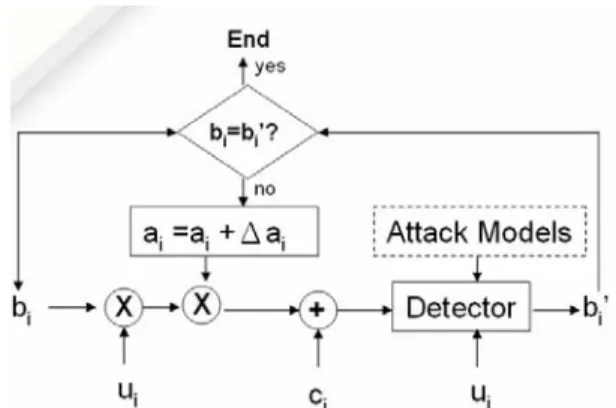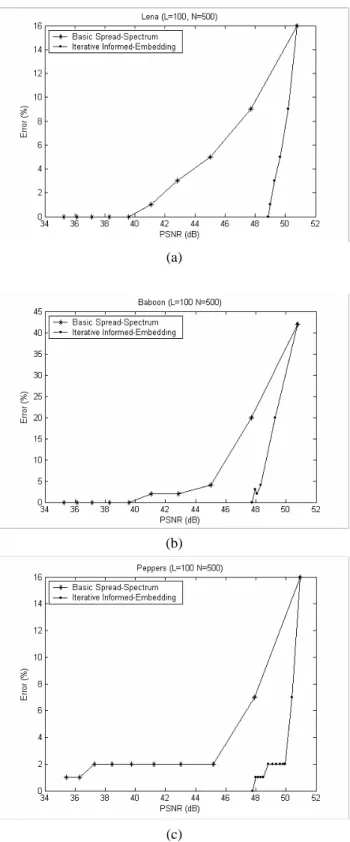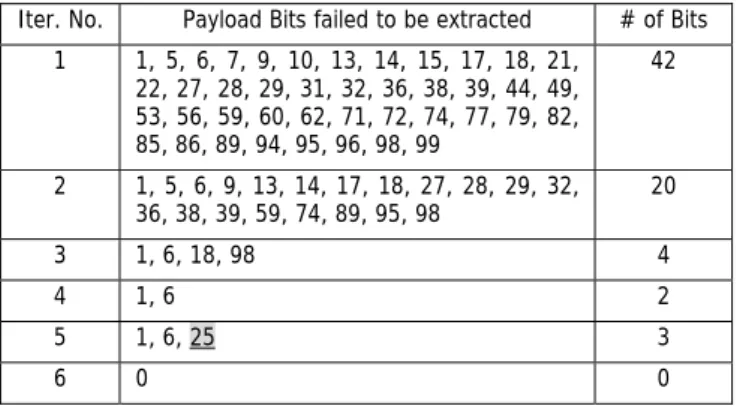Host-Interference Rejecting Spread-Spectrum Watermarking:Implementation and Implications
全文
(2) cannot precisely find out which are those largest coefficients and their relative orders before watermark embedding, the approximation above is adopted. Fig. 2 shows the detection performance of different test images given L=100, N=500. The value of a is set from 1 to 10 respectively, in other words, each point in Fig. 2 represents the marking performance of some marked image using a certain a value. As expected, the stronger the watermark is, the lower the detection error rate will be and, therefore, the worse the quality of the marked image attains.. interference problem, they do suffer from signal scaling attacks. In this paper, an iterative informed-embedding spreadspectrum approach, conceptually similar to [5], is exploited to alleviate the host-interference problems. Models, algorithms, as well as implementation details are provided to show the effectiveness of our iterative methodology. Furthermore, inherent performance losses caused by the assumption of conventional spread-spectrum watermarking schemes - watermark signals shall be added to most perceptually significant components - is pointed out. Finally, problems and practical applications of iterative informed-embedding watermarking schemes are discussed.. Figure 3 shows the watermarking performance of adopting different chip sequence lengths to embed single payload bit into the Lena image, other experimental settings are the same as the previous one. As the error estimation model provided in [4] states, the larger the chip sequence length is, the better the detection performance will be. Fig. 3 largely fits this assumption. Nevertheless, though increasing the length of chip sequence for each payload bit can enhance the detection performance against host-interference, total amount of available payload bits will be consequently reduced. Therefore, the length of chip sequence cannot be unlimitedly increased.. This paper is organized as follows. Section 2 reviews state-of-the art for the blind-detection spread-spectrum watermarking schemes. To improve its detection performance, the iterative informed-embedding methodology is introduced in Section 3. Geometric models, implementation details, and experimental results are also included. The inherent performance loss caused by some assumptions of conventional frequency-domain spreadspectrum watermarking schemes, as well as possible extensions and applications of informed-embedding schemes are investigated in Section 4. Section 5 concludes this paper.. In fact, it is obvious that the basic blind-detection scheme did not utilize any available side-information about the host interference at all. Therefore, an informedembedding approach for spread spectrum watermarking conceptually similar to the iterative scheme introduced in [5] is devised and tested.. 2. BASIC BLIND-DETECTION SPREADSPECTRUM WATERMARKING SCHEME The model of basic blind-detection spread watermarking scheme is introduced in [4] and can be illustrated in Fig. 1. m={b1,…,bL} is the payload bit-stream. Each payload bit bi is embedded into a component of the original host signal, denoted as ci. ui={ui1,…,uiN} is the pseudo-random chip sequence whose value will be +1 or -1 and it will be modulated with each bi. a is the weighing factor multiplied to the watermark sequence to control the watermark strength. The channel is often modeled as an additive noise n. In the detection side, the correlation value of the distorted stego signal and the chip sequence ui will be calculated and compared against a threshold value (0 in this scheme) to estimate the estimated payload bits. For the ease of explanation, we will focus on the host-interference only in this section, i.e. all the detection errors are caused by host-interference.. 3. ITERATIVE INFORMED-EMBEDDDING SPREAD-SPECTRUM WATERMARKING (1) System Architecture and Algorithmic Description The proposed iterative informed-embedder for the blind-detection spread-spectrum watermarking system is shown in Fig. 4. A watermark detector the same as the one in the basic scheme is now included in the embedder. In order to hide a payload stream m, the watermark strength ai for each payload bit bi will be gradually increased if the payload bit extracted is not the same as the one to be embedded. As long as a payload bit bi is correctly extracted, the value of ai stops increasing immediately. In other words, the more seriously a portion of the watermark sequence suffers from the host interference, the stronger the corresponding weighting factor will be set. The iterative process will be terminated after performing a certain number of iterations or an acceptable error rate is obtained (e.g. all payload bits can be correctly extracted). Note that the IDCT/DCT routines are still performed before sending the marked stego signal into the detector for simulating the actual host-interference the stego image may undergo, but here we don’t depict them in Fig. 4 for the purpose of clear. In our implementation, watermark signals are embedded into DCT coefficients of the test images. The embedding is done according to the zig-zag scan order from low-frequency coefficients to high frequency ones. This is an approximation of the original spread-spectrum watermarking assumption that watermarks shall be embedded into the DCT coefficients with largest magnitudes. Since in the blind-detection case, the detector. 2.
(3) successfully embed these bits and then the stability of the iterative scheme can be retained.. illustration. As for the effect of incorporating additional error model, shown as the dotted block in Fig. 4, a thorough discussion will be provided later. Fig.5 shows the detail description of the proposed algorithm.. (4) Geometric Models of Iterative Informed-Embedding Since spread-spectrum watermark detection is inherently correlation-based, geometric models introduced in [1] can be used to illustrate the proposed iterative spread-spectrum approach. Fig. 8 shows the geometric models of the basic spread-spectrum scheme; Fig. 9 illustrates the geometric model of the proposed iterative approach. In the basic schemes, using the same watermarking strength may result in detection failures or unnecessary modifications that lead to worse fidelity. On the other hand, the iterative informed-embedding approach only adds watermarks to an adequate degree so that the payload bits can be correctly extracted.. (2) Experimental Results Fig. 6 depicts the performance improvements of the proposed iterative approach, using different test images, against the basic blind spread-spectrum watermarking scheme. Experimental settings are given as follows: L=100, N=500, and ∆ a=1. The performances using the iterative approach obviously outperform those of the basic scheme. To improve the performance of our iterative scheme further, the increasing step of the watermarking strength, denoted as ∆ a, is attenuated and tested. In other words, watermarking strengths are fine-tuned to avoid unnecessary coefficient modifications. Fig. 7 shows the detection performance with ∆ a of 0.1. As we expected, performance improvements achieved via iterative informed-embedding approach can be further improved by adopting finer iterative step of watermarking strength. In other words, watermarking performances are improved at the cost of performing more iteration, that is, more computation resources are involved to produce better marked works.. 4. DISCUSSIONS (1) Inherent Performance Loss Due to Assumptions of Conventional Spread-Spectrum Watermarking In addition to that watermarking performance can benefit greatly from adopting the iterative informedembedding methodology, some more implications are given by carefully examining the experimental results. Roughly speaking, embedding payload bits corresponding to low-frequency DCT coefficients requires larger watermarking strength (i.e., more iterative operations in the iterative approach).. (3) Oscillations around Detection Threshold It is worth noting that, during each iterative process, the performance improvement might not increase monotonically. For example, as shown in Fig. 6(b), the detection error rate of the fifth iteration is even higher than the fourth iteration. To clarify this seemingly unreasonable phenomenon, payload bits fail to be correctly extracted in different iterations (corresponding to Fig. 6 (b)) are listed in Table 1. In this case, the 25th payload bit that can be correctly marked in previous iterations fails to be extracted correctly during the 5th iteration. For iterative schemes using finer increasing step, such phenomenon occurs more frequently, as shown in Fig. 7.. This phenomenon is a reasonable result due to the characteristic of the chosen host signal – the zigzag ordered full-frame DCT coefficients. DCT coefficients possess a tendency of magnitude decreasing from low frequency regions to high frequency ones, therefore, the first few payload bits will be embedded into coefficients with larger magnitudes. This is the desirable property of the original non-blind spread spectrum watermarking schemes since coefficients with larger magnitude are more perceptually significant and will be more robust against media compression. However, without original contents in the detection side, the host signal now becomes a troublesome interfering noise. The larger the noise energy is, the worse the watermark detection will result, and consequently, stronger energy of the watermark signal shall be provided. However, since the fidelity of marked content depends highly on the energy of the signal, it is impractical to arbitrarily enlarge the watermark energy, especially for those perceptually significant low-frequency coefficients. Therefore, the embedding positions are shifted afterwards to alleviate this inherent performance loss. Fig. 10 shows the performance comparisons between the basic spreadspectrum scheme, the iterative informed-embedding approach, and the informed embedding-approach in with. We name this phenomenon as oscillations around the detection threshold. That is, the correlation values corresponding to some payload bits altered due to modifications in DCT coefficients in other positions, thus leading to wrongly detected payloads. Though, theoretically, DCT is a one-to-one transform, altering certain DCT coefficients may result in slight changes in other coefficients because of limited precisions and rounding errors of image representations. Since amounts of correlation values over the detection threshold based on the weakly-embedding nature of our iterative scheme are small, wrong detection results may be produced. Fortunately, this situation never lasts for a long time because the energy of corresponding watermark signals will be increased to. 3.
(4) system. In addition, associating value-added metadata with lossy-compressed contents also possess similar system characteristics. Therefore, performance of such applications can benefit greatly from the (iterative) informed-embedding schemes.. all embedding positions are shifted by an N-coefficient offset toward the higher-frequency coefficients. According to Fig. 10, the embedding-positions shifting approach does improve the watermarking performance further. Though shifting the embedding positions into higher frequency can further improve the performance of watermark detection, unlimited backward shifting of embedding positions will undoubtedly suffers a significant loss in robustness. However, according to the experimental results, the assumption that traditional spread spectrum algorithm insist: watermarks shall be embedded into the most perceptually significant positions do introduce inherent loss of detection performance for the blinddetection scheme.. 5. CONCLUSIONS In this paper, empirical detection performance of basic frequency-domain blind-detection spread spectrum watermarking is observed. Furthermore, possible enhancement through adopting iterative informedembedding scheme is evaluated. Geometric modes, implementation details and possible applications are provided. Furthermore, the original assumption that original non-blind spread spectrum watermarking schemes followed to embed watermark signals into perceptually significant components may introduce loss of detection performance for the blind-detection cases, and a simple solution is discussed.. Frequency-domain watermarking schemes are notable for their better robustness and fidelity over spatial-domain schemes. However, the energy packing capability and larger dynamic ranges of digital transforms may result in strong host interference for blind-detection watermarking schemes, at least for schemes based on correlation values of pseudo-random signals such as the spread-spectrum watermarking.. 6. ACKNOWLEDGEMENT This work is supported by NSC94-2752-E-002-006-PAE, “Multi-Modal Content Organization”, National Science Council, R. O. C.. (2) Concerns about Incorporating Attacking Models As shown in Fig. 4, the iterative informed-embedding approach can be extended by incorporating error models that describe attacks the marked contents may undergo. However, all informed-embedding approaches face a difficult problem: precisely grasping all important attacks is far from reality. According to [5], obvious improvements in robustness can only be achieved for attacks being considered during watermark embedding only. Nevertheless, our host-interference scheme can successfully remove all host-interferences and be adopted to be basis of informed-embedding approaches taking certain attacks into considerations. Effects of attacks described by known error-models can be iteratively removed by the proposed iterative informed-embedding methodology.. 7. Reference [1] Cox, I. J., Miller, M. L., and Bloom, J. A. Digital. Watermarking, Morgan Kaufmann Publishers, CA, 2002 [2] Cox, I. J., Kilian, J., Leighton F. T, and Shamoon. T,.Secure Spread Spectrum Watermarking for Multimedia. IEEE Transactions on Image Processing, vol. 6, December, 1997 [3] Marvel L. M., Boncelet C. G., Retter C. T., Spread. Spectrum Image Steganography, IEEE Transactions on Image Processing, vol. 8, no. 8, August 1999 [4] Marvar, H. S. and Florencio, A. F., Improved Spread. Spectrum: A New Modulation Technique for Robust Watermarking, IEEE Transactions on Signal Processing, vol. 51, no. 4, April 2003. (3) Appropriate Applications of Informed-Embedding Approaches Though all informed-embedding schemes suffer from the difficulty of predicting all possible error models, they are appropriate for many feasible and important applications. For example, in a typical steganography scheme, guaranteed robustness is an important concern (e.g. a 100% correct extraction is required for decryption of the hidden payloads without adopting error-correcting codes), and all errors, including the host-interference and required lossy compression, are controllable during watermark embedding. Fig. 11 shows the architecture of a typical steganographic. [5] Miller, M. L., Watermark Embedding for Black-box. Channels, Proceeding of International Workshop on Digital Watermarking 2003 (IWDW 2003), Seoul, October, 2003 [6] Chen,. B. and Wornell G. Quantization Index Modulation: A Class of Provably Good Methods for Digital Watermarking and Information Embedding, IEEE Transactions on Information Theory, vol. 47, pp1423-1443, May 2001. 4.
(5) Fig. 1 The basic watermarking scheme.. blind-detection. spread-spectrum Fig. 4 In an iterative informed-embedder, the weighting factor. for hiding each payload bit is iteratively increased until that payload bit can be correctly extracted. Fig. 2 Performances of the basic blind-detection spreadspectrum scheme using different test images and different watermarking strength, controlled by a, are illustrated.. Fig. 5 The algorithm of the proposed iterative informedembedding approach. Fig. 3 Increasing the length of chip sequence, denoted as N, adequately can substantially improve the detection performance of the spread-spectrum watermarking system.. 5.
(6) (a). Fig. 7 Using finer increasing-step of watermarking strength can further increase the performance of iterative informedembedding approach.. (a). (b). Fig. 8 The geometric model of the basic spread-spectrum watermarking scheme. Fixed watermarking strength may result in (a) failure of detection or (b) more-than-required host-signal modification.. (b). (a). (b). Fig. 9 The geometric model of the iterative informedembedding approach is shown. No matter the hostinterference is large or small, adequate amount of watermarking strengths that lead to successful payload-bit detection and minimal coefficient modifications can be iteratively decided.. (c) Fig. 6 Performance improvements obtained by the proposed iterative informed-embedding against the basic spread-spectrum system, using (a) Lena, (b) Baboon and (c) Peppers, are illustrated.. 6.
(7) Fig. 10 The watermarking performance can be further improved by adequately shifting the embedding positions toward higher-frequency coefficients.. Fig. 11 The system architecture of a typical steganography system.. Table 1. Payload bits fail to be correctly extracted are listed Iter. No.. Payload Bits failed to be extracted. # of Bits. 1. 1, 5, 6, 7, 9, 10, 13, 14, 15, 17, 18, 21, 22, 27, 28, 29, 31, 32, 36, 38, 39, 44, 49, 53, 56, 59, 60, 62, 71, 72, 74, 77, 79, 82, 85, 86, 89, 94, 95, 96, 98, 99. 42. 2. 1, 5, 6, 9, 13, 14, 17, 18, 27, 28, 29, 32, 36, 38, 39, 59, 74, 89, 95, 98. 20. 3. 1, 6, 18, 98. 4. 4. 1, 6. 2. 5. 1, 6, 25. 3. 6. 0. 0. 7.
(8)
數據



相關文件
Students are asked to collect information (including materials from books, pamphlet from Environmental Protection Department...etc.) of the possible effects of pollution on our
Wang, Solving pseudomonotone variational inequalities and pseudocon- vex optimization problems using the projection neural network, IEEE Transactions on Neural Networks 17
volume suppressed mass: (TeV) 2 /M P ∼ 10 −4 eV → mm range can be experimentally tested for any number of extra dimensions - Light U(1) gauge bosons: no derivative couplings. =>
Define instead the imaginary.. potential, magnetic field, lattice…) Dirac-BdG Hamiltonian:. with small, and matrix
For ASTROD-GW arm length of 260 Gm (1.73 AU) the weak-light phase locking requirement is for 100 fW laser light to lock with an onboard laser oscillator. • Weak-light phase
• Formation of massive primordial stars as origin of objects in the early universe. • Supernova explosions might be visible to the most
We propose a primal-dual continuation approach for the capacitated multi- facility Weber problem (CMFWP) based on its nonlinear second-order cone program (SOCP) reformulation.. The
The difference resulted from the co- existence of two kinds of words in Buddhist scriptures a foreign words in which di- syllabic words are dominant, and most of them are the